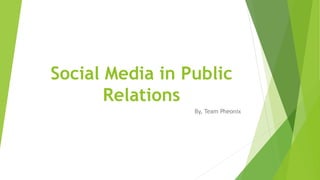
Chapter 4 Presentation Group 3
- 1. Social Media in Public Relations By, Team Pheonix
- 2. Solis Social Media PR PR formula centers on ART to impact outcomes, behaviors, and actions. Actions Reactions Transaction PR’s objective is to influence the C-suite referring to top senior level executives at a corporation who makes key decisions and have power to spend money. EX. chief executive offers (CEO), chief operating officers (COO), chief information officers (CIO), and chief digital officers (CDO) https://youtu.be/pMS5Iu0psDY
- 3. PR Management Clients want a return on their investments (ROI), simply including social media in a campaign is not enough anymore, it’s become an eCommerce environment where companies try to: Increase website traffic Generate sales leads Increase conversations and online purchases Reduce company expenses Improve customer relations and awareness
- 6. PR Management Key Performance Indicators (KPI’s) focus on continuous monitoring of social media and sales activity data Friends are most influential It’s important to measure influence on social media, many people use KLOUT algorithm to track broad engagement across a large number of social media platforms Owned Media – company owned media such as website and apps Hybrid Media – new media that incorporates old media rules; emerged from blogging Facebook, Twitter, and Youtube empowered individuals to act as media producers. Smartphones and tablets crated the need for apps, and new platforms.
- 7. 5 Content Archetypes Curated Content: managed by brands determining “highest value to customers” Co-created Content: co-produced either peer to peer or brand to participant Original Content: exclusive brand messages Consumer-generated Content: happens without brand’s involvement Sponsored Content: “paid promotion” Promoted Posts: appear on Facebook and are similar to a paid search
- 8. Social Capital, Conflict, and Collaboration Social Capital – refers to the ability of individuals organizations to benefit from communication behavior Individual and organizational social capital may: Have value in economic terms Other benefits for professional development -
- 9. Social Capital, Conflict and Collaboration (Continued) Social capital is a way to understand intangibles important within communities: Trust – information, knowledge, skills Shared norms and values – understanding of others Shared resources and knowledge – wider access to resources and knowledge Reciprocity – likely that others in network will reciprocate and give to relationship Resilience within relationships – strong networks are resilient when facing challenges Co-ordination and co-operation – for the achievement of common goals Social networking and media used to cultivate social capital should generate opportunities to collaborate beyond typical boundaries
- 10. Social Media Tactics Historically, PR people relied on the simple press release or news release In the digital era; every release of information should be designed for online consumption by news media and general public In the world of social media, PR people are in search of ‘traction’ To break through the clutter online they must use SEO keywords and structure them to move to the top of Google searches “Buzz” techniques = rich media content such as: Photographs Audio Video Info Graphics Links
- 11. Social Media Tactics (Continued) PR professional must be strategic by offering timely information Real time PR professions often work from “war rooms” – ready to respond Social media often blurs the lines between PR, advertising, and marketing PR – emphasizes brand awareness, influence or positive sentiment Marketing – seeks conversation from interaction to sales
- 12. Social Media Tactics (Continued) 9 most important platforms: Twitter Facebook Google+ Instagram LinkedIn Tumblr Pintrest Vine Snapchat
- 13. PR Newsrooms and Message Targeting Edelman PR developed its Creative Newsroom to address the need for: real time social media monitoring, response, and strategy Focuses on client media storytelling for engaging audiences Real time social media is transforming marketing and public relations Traditional media – television, radio, newspaper, magazines, are beginning to blend with real time PR and marketing content
- 14. PR Newsrooms and Message Targeting (Continued) Integration of digital requires PR newsrooms to keep brand names alive on trending charts Public relations newsrooms should encourage participation by: Being at the center of a PR office Monitoring traditional and social media Developing a mindset of constantly generating ideas for clients -
- 15. PR Blogging and Case Studies PR blogging is a new way in which brands are voiced throughout social media platforms Some bloggers are paid by companies, but many are independent and unpaid Through the use of social media, PR professionals find ways to be creative and gain brand interest Social media is positive for brand recognition, customer loyalty and sales
- 16. PR Blogging and Case Studies (Continued) PR uses social media to: Reward loyal customers Cover press conferences Use hashtags to connect new brands to potential customers
- 17. Corporate Social Responsibility (CSR) The effect businesses have on social and environmental conditions. CSR is seen as a way to develop legal, ethical and global practices within large corporations. Self-Regulation for companies to showcase social responsibility. “Positive CSR can result in increase brand loyalty in consumer who value socially responsible products and company behavior.”
- 18. Corporate Social Responsibility (CSR) (Continued) Non-Profits: They gain the most from the social media communication PR shift. They benefit through earned media because they lack funds for paid media. Through social media, non-profits generate more awareness in social friends and fans. Successes: The CEO is the major force in creating PR success. If the CEO is using social media, he or she have a greater influence. They offer more credibility to the brand, product or organization Failures: The improper use of social media can result in the PR failure. Distributing a message without filtering, fact checking, or strategically planning can cause backlash and damage a brand or company